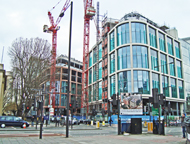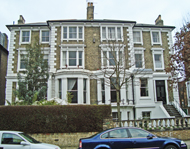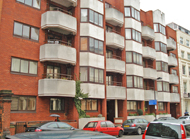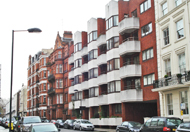Terminal care, convalescence
In 1893 Dr Howard Barrett (1842-1921) opened a home for the dying poor - St Luke's House at 50 Osnaburgh Street, near Regent's Park. The Home was a forerunner of the hospice movement.
Dr Barrett had been a young doctor in the East End of London and had experience there of the epidemics caused by cholera and smallpox, and of the effects of famine during the dockyard strikes. As soon as possible, he set up a practice in the West End, which soon became prosperous. Once he had established himself professionally, he felt he could afford to help the sick poor.
In 1888 he became the first Medical Director of the Medical Department of the West London Mission, a Wesleyan Methodist initiative, working alongside his brother-in-law, Revd Hugh Price Highes, the Chief Missioner. The Medical Department consisted of a District Nursing Service, which was divided into two districts, each with two trained Sisters, a Dispensary to which patients were referred by the Sisters to be seen by voluntary medical staff, and a creche where working mothers could leave their children during the day.
However, Dr Barrett was also interested in another venture - to provide a 'home of peace' where the respectable poor could end their days, thus avoiding the stigma of pauperism by being admitted to a workhouse infirmary (the dying poor often lived in squalid and degrading conditions). He found a house in Osnaburgh Street which was in need of repair. The building was duly renovated and St Luke's House ('Home for the Dying Poor') was officially opened by Lady Battersea in June 1893. It was the first such institution established by a medical man for patients who could not be cured.
St Luke's House had 16 beds in four wards; the male ward had 6 or 7 beds and the female 8 or 9, with 2 isolation rooms for 'special cases or circumstances'. The wards were furnished more like middle-class bedrooms, with potted plants, ferns, easy chairs, pictures and texts. Window boxes were planted with marguerites and geraniums, and a small yard was converted into a garden. Nursing care, an adequate diet and opiates were provided in a clean, comfortable environment. The resident staff comprised a Matron, two nurses, one probationer and a few domestic servants. There were three visiting physicians and surgeons, including Dr Barrett himself.
Although run under the auspices of the West London Mission, the Home was open to all denominations. However, patients had to be respectable and near to dying, that is, with no more than three to four months to live (many had less than this - the average length of stay was two months). The patients were upper working and lower middle-class - clerks, policemen, craftsmen, commercial travellers, engineers, printers and even solicitors, accountants, managers and clergymen. Female patients usually had been governesses, dressmakers, laundresses, nurses or domestic servants. Some labourers and porters were admitted on the grounds of good character. Their friends or relatives had to agree to remove the body (or the patient, if found to be suffering from chronic disease and not dying).
Tuberculosis was the most common cause of death. The second was cancer, although patients with cancers that gave rise to offensive odours were not admitted, for the comfort of other patients. Unmanageable patients with functional brain disorders were also excluded for the same reason. Heart disease was the third reason for admission. In 1896 the average age of the male patients admitted to St Luke's House was 34 years and 43 years for females.
The house at Osnaburgh Street was cramped and not ideal, so in 1900 it was decided that more suitable accommodation was needed. Two adjacent houses in Lawn Road were bought and converted into one. Following redecoration and refurbishment, the Home moved to Lawn Road in 1901. It had 26 beds. However, the neighbours were not so keen on having a House of Dying nearby, which could affect property values. A speculative builder, who had built two houses opposite, feared he would not be able to let them and complained to the ground landlord. The Home received an eviction notice and, despite its appeals and the fact that the two houses opposite had been let, was forced to close in January 1902.
The patients were accommodated in other institutions while Dr Barrett searched for new premises. Some 60 estate agents were approached and advertisements placed in newspapers; 187 houses were inspected, but ground landlords objected to the use of their property for such purposes.
Finally a large house in Notting Hill Gate was found and the lease signed directly with the ground landlord (the lease stipulated that the Home should look like a private dwelling). Following internal alterations and adaptations, St Luke's House reopened at 14 Pembridge Square in June 1903, with 35 beds. In 1904 Queen Alexandra became its Patron.
In 1908 the Home gained publicity when a young factory girl named Martha Massey, who was dying of TB, wrote to Queen Alexandra saying how much she would like to meet her. Four days later the 64-year-old Queen arrived in a large white motor car, with her daughter Princess Victoria, a lady-in-waiting and an equerry. The parlour maid was too agitated to announce her so, without ceremony, the Queen flung open the door to Matron's office. The surprised Matron recognised her and took her to Martha's ward. The Queen presented Martha with a bouquet of Alexandra orchids, lily-of-the-valley and asparagus fern, introduced her daughter to her as 'Victoria' and chatted with her about her illness. She then visited the other patients, distributing the same number of roses to each. As she was about to leave she heard Martha coughing and sent the equerry to the car for a box of throat lozenges, putting one personally into the girl's mouth. Although the Queen's visit had been private, it was reported in the newspapers the next day. The story captured the public's imagination and gained the Home much financial support and acceptance as a neighbour.In 1911 the West London Mission ceased to be connected to the Home, even though it had never given it any financial backing. In 1914 Dr Barrett retired as Honorary Medical Superintendant and was succeeded by his son Edmund, who had qualified at St Mary's Hospital. However, Dr Barrett remained chairman of the Management Committee until 1921, when he died at the age of 79 years. By this time St Luke's House ('Home for the Dying Poor') had been renamed St Luke's Hospital for Advanced Cases, so that sensibilities were not so affected.
At the beginning of the 1920s the lease on 14 Pembridge Square was about to expire. As it was not renewable, a move was necessary. A freehold site in Hereford Road was purchased, just around the corner. Work began on the erection of a purpose-built Hospital, which opened in 1923. An existing house at 22 Pembridge Square was retained as a Nurses' Home.
The Hospital building survived unscathed during WW2 with not even a broken window, but staffing shortages caused by enlistment to the armed forces meant that the wards on the top floor had to be closed. During the late 1930s or early 1940s, by trial and error (no accurate records had been kept), it had been found that by giving them medication 4-hourly, rather than as needed, patients could be kept far more alert and comfortable all the time.
The Hospital reopened fully in 1945 with 48 beds. A mobile X-ray unit was installed. Terminal cases of TB, as well as lymphadenoma, tabes dorsalis (neurosyphilis), heart disease and diabetes were admitted, but the majority of patients now suffered from cancer. A link was forged with the Royal Cancer Hospital so that patients with certain types of cancer could receive chemotherapy. Relatives or friends of the patients were required to deposit 10 shillings (50p) to cover any expenses incurred during the discharge or death of the patient. Any remaining money was refunded if the patients was discharged, but no refund was given if the patient died.
In 1948 the Hospital joined the NHS and became associated with St Mary's Hospital. The founder of the modern hospice movement, Dame Cicely Saunders, worked as a volunteer nurse for seven years at St Luke's Hospital.
In 1974 the building was renovated and the Hospital renamed Hereford Lodge (the association of St Luke's with advanced cases and dying was considered too depressing). It had 42 beds for pre-convalescence and terminal care.
Hereford Lodge closed in 1985 and its functions were divided between St Charles Hospital and the Paddington Community Hospital.
Present status (March 2008)
The building has been demolished and the site is now occupied by 'Evesham House', an apartment block built in 1990.


The first site of St Luke's House in Osnaburgh Street (left) has been redeveloped many times. The second site (right) was at 13-14 Lawn Road, Hampstead. The building has survived and seems to have reverted back to two separate houses, with No. 14 seen on the left and 13 on the right.


Evesham House contains 25 two- and three-bedroom apartments and one penthouse, with underground parking.
Brown K 1993 A undesirable neighbour: St Luke's House for the Dying Poor. St Mary's Gazette 99, 34-36.
Goldin G 1981 A protohospice at the turn of the century: St Luke's House, London, from 1893 to 1921. Journal of the History of Medical and Allied Sciences 36, 383-415.
Granshaw L, Porter R (eds) 1989 The Hospital in History. London, Routledge.
www.british-history.ac.uk
Return to home page